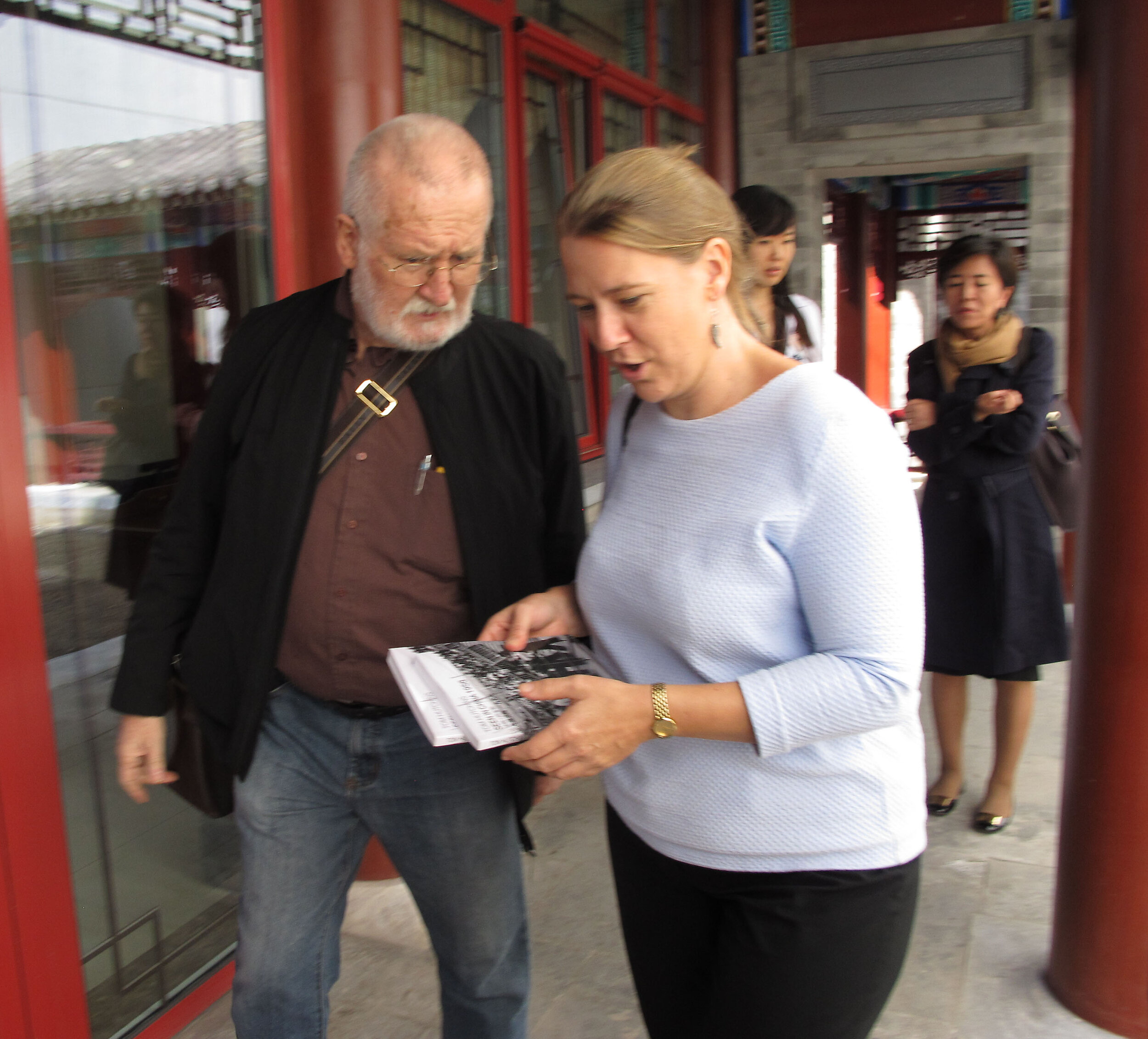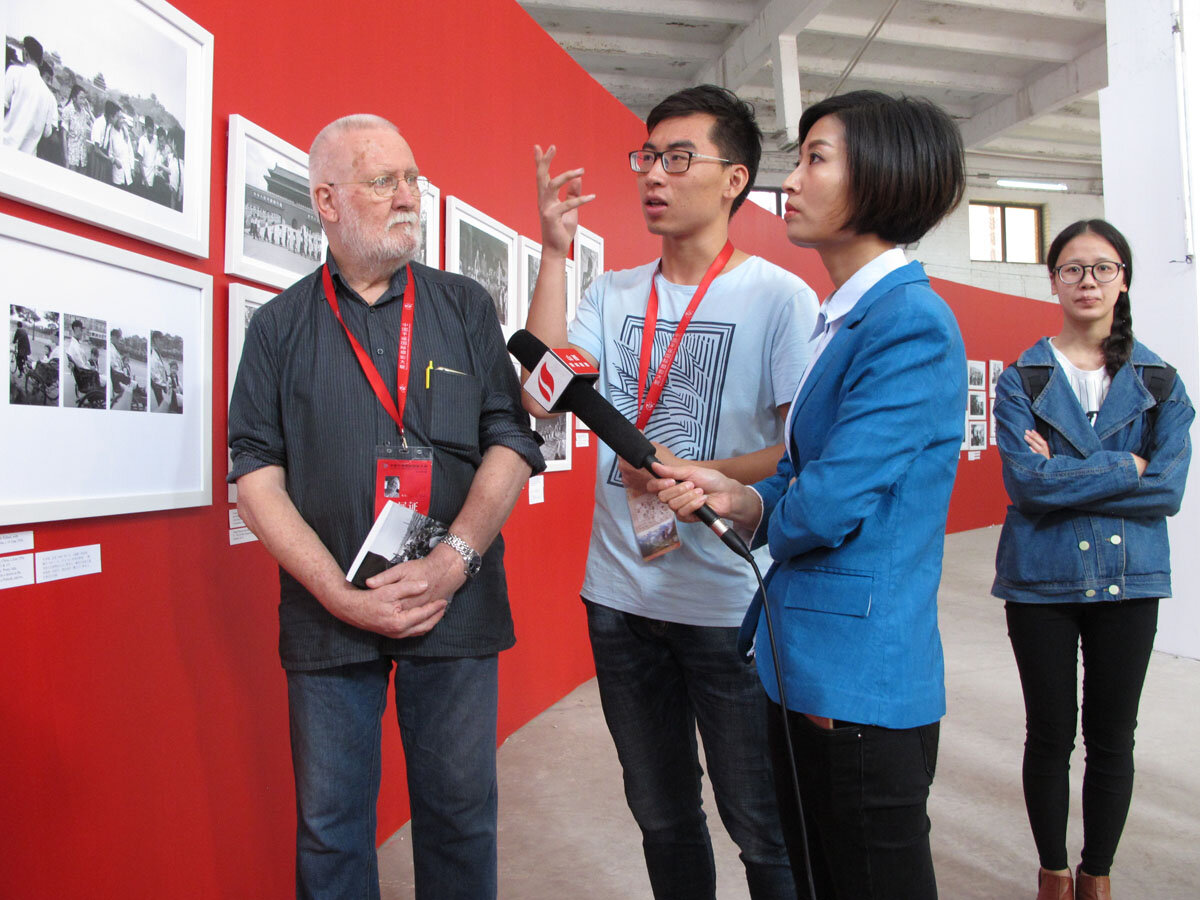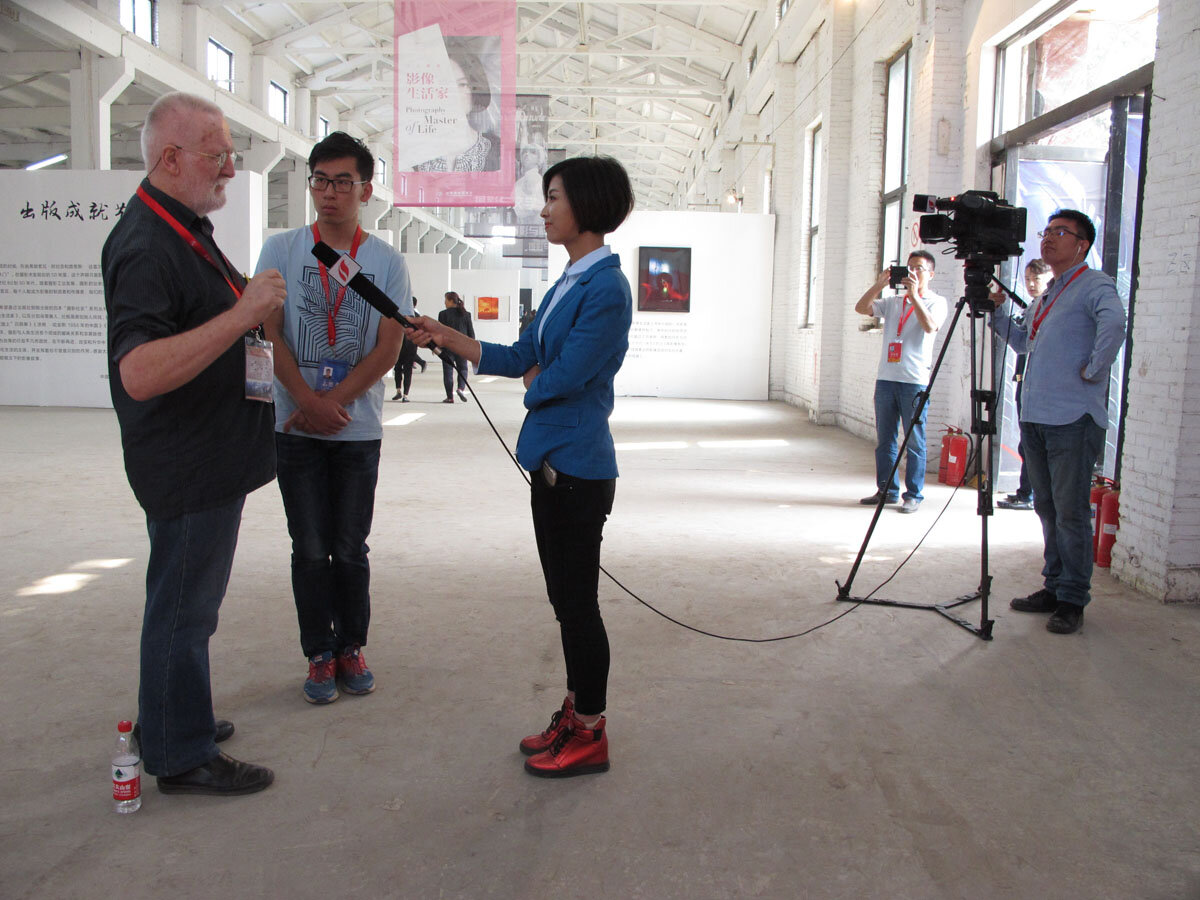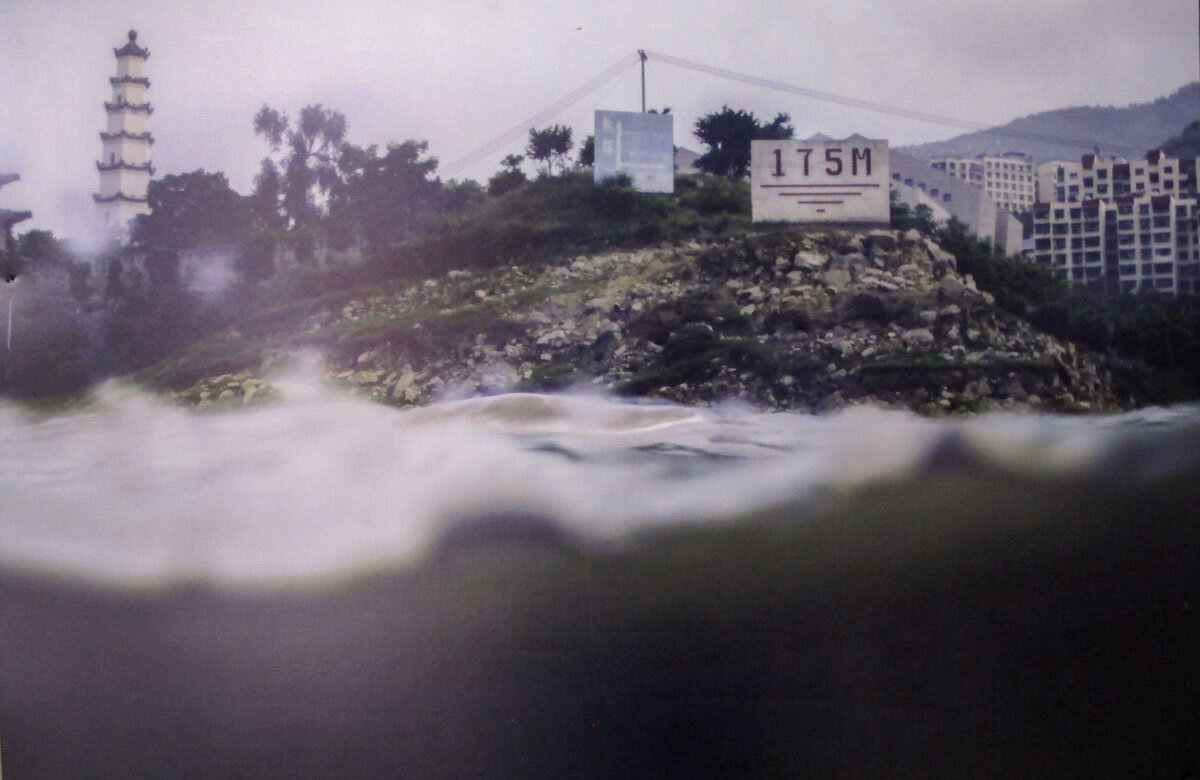Pingyao International Photography Festival, 2016
Report for PhotoForum from Stu Sontier at Pingyao International Photography Festival, 2016.
The festival is well under way now and the craziness of hanging and captioning well behind us. This year, John Turner has curated an approx 100 image show of Tom Hutchins’ work from 1956, and I am here as the PhotoForum representative.
We both arrived on the 17th with the exhibition to open on the 19th. There was no sign of our framed prints so we killed time meeting a local photographer friend of John’s.
The following day we, and our 3 assigned helpers, had to first unpack and then arrange the pictures in order. Then came the task of arranging them on the wall, with less space than we had expected.
We gradually worked our way through a number of problems including missing pictures and reformatting and printing captions, finishing late in the evening. Although without captions on the wall. Throughout the hanging we already had a stream of people coming through, peering closely, taking pictures of the pictures and pictures of us with the pictures, and selfies with the pictures. Pictures of anything it seemed.
The following morning we were treated to what can only be called an extravaganza of Chinese proportions, with huge video displays showing bizarre cartoons for some unknown reason. There were some formal speeches as there are at such things but the main purpose seemed to be to get the foreign photographers out in public and subject them to what they sometimes impose on others. Again we were photographed photographing our peers photographing all manner of subjects and in a sign of the time we were also filmed from above by several drones.
The military, police and swat teams were all out in force but generally used just to keep the photographers under control. After these formalities and another million pictures added to the global stock bank, we came back to our show to interact with the audience.
Pingyao is awe inspiring to say the least, with the work of 200 overseas and 2000 Chinese photographers on show. The visitor number is huge too and an uncountable number are moving through the space, with greater or lesser levels of interest. John has been interviewed numerous times with at least two TV crews being on the list. We’ve also started visiting a few of the many other exhibitions and meeting some of the many local and overseas photographers. That includes the other NZ contingent, who are part of a curated show by Rosanna Raymond and organised by the Auckland Festival of Photography. The show, Ata Te Tangata, showcases Pacific Island photographers with a range of cultural interests. Four of the photographers, and the curator are in Pingyao, and all, with John, participated in the “Dialogue with NZ Curators and Photographers” with a good audience turnout.
The festival continues for another two full days and as a first time visitor, I can recommend attending if you want a mix of culture shock, great food, misinterpreted English and Chinese (learn a little), and an awful lot of photography covering many genres and at many levels, from top local and international names, to outstanding student work.
Report Part Two:
I gave a summary of the install and opening of the Pingyao International Photography Festival (PIP) a few weeks ago. Time has passed and it’s taken a while to be able to report on the running and conclusion, partly because of the need to clear my head of the crazy China experience which included a trip to Beijing with John Turner as host.
John Turner with Melissa Crawford from NZ Embassy, with Phoebe Li in background
In Beijing I saw the follow-on from the initial interest in “Tom Hutchins – Seen in China 1956”. This included stronger interest in a new show that John is curating with Phoebe Li (“Recollection of A Distant Shore: A Photographic Introduction to the History of the Chinese in New Zealand”) which opened on 21 Oct at the Overseas Chinese History Museum of China. The Chinese Photographers Association filmed him talking about Tom Hutchins for a film documenting their 60-year history, as part of a teaching curriculum.
China Daily report on Recollection of A Distant Shore
Some of this was the result of the high level of interest in “Tom Hutchins – Seen In China” at PIP. The installation pictures show that we were given a very prominent position with a huge poster image and text in English and Chinese facing the front door of Diesel Factory A2. We also found that we had a rich red wall which really made the black and white images ‘ping’ and even with the crowding of the 89 images the show looked stunning. This came courtesy of Zhang Guotian, the director of the festival who seemed to have taken a personal and professional interest in the show, emphasising the importance to Chinese at a number of levels.
Director Zhang Guotian with John Turner. As well as the photography, we got to eat wonderful food with wonderful people.
On the first day, a communist party contingent came to view the show, and the entourage flew through so quickly that we missed documenting it. John and I spent some considerable time talking with the many visitors on the first two days and we saw a large audience from young to old, with the elderly often taking an especial interest. One of John’s hopes is that an adult visitor recognises themselves as a child in or near a picture that Tom took, and can recall the ‘lao wai’ – foreigner with the camera who came through in 1956 – this person would obviously be older than 60 now.
Shanxi TV reporter with John and translator Chin Jay
We also had a visit from Shangxi province TV reporters. The reporter seemed to have (mostly) done her homework and came prepared for a good length interview. She followed up with clarifying questions and produced a good segment that can be seen here:
http://www.sxrtv.com/content/v/a/2016-9-24/1474716057174.shtml?from=singlemessage&isappinstalled=0
Shanxi TV reporter with John and translator Chin Jay
The site has a transcript in Chinese but a translate app like Google Translate (unavailable if you are in China without a VPN) will give an approximate version.
One result of the level of interest in the show is that the NZ embassy has got behind the Chinese in NZ show and it is hoped that they may help with further stages of the Tom Hutchins project that John is working on. The history of the Chinese in NZ show is scheduled to open at the Auckland Museum in February 2017.
After the hard work and excitement of the first couple of days we managed to venture further afield to see some of the many other exhibitions.
Despite the variety and quality of the work on show, one of my personal concerns was that Pingyao is very much about traditional photography as opposed to ‘lens based art’ and because of this there seems to be a pinch on experimentation. A lot of the work that was trying to be challenging seemed to apply self imposed bounds. One work that showed promise was 4 framed ‘pictures’ that turned out to be video projections of torsos that were just perceptibly breathing but at a quick glance appeared to be straight photos.
Another, that sought to bring in political content and used multimedia, was ‘Since Then, No One Has Talked With You’ by He Bo. Based around recent terrorist bombings, the large full face portraits of attackers were built from small images of varying density, then overlayed with very tiny red faces of victims that built up a morse code message across the surface of the pictures. Small boxes on the wall, when opened, held typed messages.
There was perhaps too much layered meaning for me to work through (having to decode the morse was just a bit much) but I applaud the attempt to try and make personal meaning and public statement about political terror acts that impact many of us as individuals and as a society.
Installation - He Bo
As well as a lot of commercially oriented work, there was some wonderful student work in the 7 huge buildings set aside for universities, and probing work in the Group Exhibition of Female Photographers. One in particular, by Chan Oi-Yan was inspiring to see. It looked at a Hong Kong wetlands area ‘beautified’ into a tourist hotspot. Her text started “Land use can hardly stop its pace due to the intense population…” Her pictures contrast the fog-covered beauty of the area with the disorganised look of a native wetland. “The nature faked a natural scene, humans? do it well too”.
Work by Chan Oi-Yan
The tall and striking character of Xu Hao held also a critical intellect that gave her images (in a series called ‘Home’) an ability to question consumerism and its power to manipulate human needs. The mundanity of Ikea store interiors, with a price tag on everything, was where she set up a camera and captured people treating the mock Ikea home displays as their own. Families lounging as if at home, in-store but looking out as if wondering whether something was lost “… where people seemed to forget their beating hearts”.
Work by Xu Hao
Tu Chun at home in his space
The photographs of Tu Chun, whilst superficially similar to Xu Hou because of the interiors in artificial light, were very different in intent. I sat with Chun for a long while enjoying his infectious smile in his own makeshift ‘home’ for the time of the festival, while he told me how he photographed immigrant families living in China. These interiors were real homes, styled by the owners themselves, the pictures considered and full of respect for the participants.
Tun Chun. Mobbed by spectators
Peng Xiangjie showed some arresting, rich, black and white images of a dwarf community that appears to be both exploited and given a liveable job and lifestyle in a commercial theme park. I learnt this by talking to Peng for an hour through a translator. He sees Arbus as a strong influence but his approach with subjects seems much more long term and considered. Intense in his consideration of his own work and able to talk about the social politics, nevertheless, like many photographers he is mindful of his career, and this could influence the scope of his work.
http://cargocollective.com/PengXiangjie
http://www.photoint.net/detail_news_3638.html
Works by Peng Xiangjie
As mentioned previously, the New Zealand show from the Auckland Photography Festival, curated by Rosanna Raymond, gave space for Maori and Pacific Island photographers who look at their place in New Zealand in quite a different way to the Pakeha view that we often get. Many of the images can be seen at the link and some of the standouts for me were the constructed psycho sexual scenarios by Russ Flatt and the edgy and potentially conflicted work of Emily Mafile’o.
http://www.pip919.com/31/161309855.html
Works by Emily Mafile'o
Peng Xiangjie and Claudia Fährenkemper interact with Claudias Armor work
The quality and interest value of the international shows was high, with known photographers such as Bruno Barbey, Claudia Fährenkemper and Marcus Lyon and many other equally interesting people and work. Even with the days I had, I didn’t get through nearly enough. Visitor numbers just seemed unlimited, and it appears all the forums and talks were very well attended. Chinese photographers value the opportunity to meet and question overseas photographers.
Seeing Marcus Lyon’s work ‘in the flesh’ was inspiring, although it took until I got home and read about his intent that I really came into his work. This is a thing I despair over with galleried shows and festivals. They generally still treat the single image as ‘a work that communicates without language’. My personal viewpoint rejects that as outdated and untrue. I’m interested in the individual motivation and the politics that invade even a non-political picture. I might get hints of this from an image and some more from a series or curated show. But so much more can come out, inspire and move me if I can connect image with words and go back and forth.
I didn’t know, for instance, that Lyon creates his single images with digital manipulation, e.g his iconic “Exodus II, Dubai, UAE, 2010” – 750 cars filling the 12 lane Sheikh Zayed Road in a perfect grid, is in fact a composite of 1000 images. Lyon: “I think an image taken at 125th of a second is kind of a lie” … He works up a final image with a goal of having the viewer ask “Is that really the world we live in?” This is the thing that really gets me buzzing and going back into the picture, but I had to come home to find it.
https://www.theguardian.com/artanddesign/2015/feb/18/marcus-lyon-best-photograph-sheikh-zayed-road-dubai
Outside the Three Gorges installation
A group show themed on the Three Gorges Dam was shown in a rundown area of the Cotton Mill buildings where you had to almost crouch down to enter a layered and dilapidated series of gloomy spaces. A variety of photographers presented work related to the dam and the forced migration of more than a million people in a variety of ways from straight documentary through to conceptual.
Three Gorges Installation space
There were flaws to be sure, and it did give the impression that activism around the dam and the continuing social and ecological impact is a fait-accompli but nevertheless it was exciting to see the topic so strongly raised and it would be great to see Pingyao continue raising such topics.
Three Gorges Installation - 175 metre mark - Zhang Yi
Three Gorges Installation - I Built The Dam - Guan Zhenzhu
So political intent was apparent at Pingyao in more than one way, but maybe the biggest political event was created by the local Communist Party representatives who seemed to be on orders from Beijing to do just the opposite.
‘Jean-Pierre Laffont Legendary Photographer’ was a top-billed show with Laffont speaking at the opening ceremony. His work covered major political events through recent American history, yet the work was not immune from the flimsy and fickle hand of Chinese censorship. Twenty two images were removed from the large show with no warning.
One of the removed Laffont pictures
Rumours circulated about which images and why, but the best and damning summary comes from Jean Loh in this article:
http://www.loeildelaphotographie.com/en/2016/10/12/article/159922682/pingyao-photographers-paradise/
and commented on by John Turner: “…it is time the Communist Party actually listened to its art experts and stopped insulting them with petty, dense and foolish censorship”.
The pictures removed included fairly mild nudity, some images of Rajneesh or Hare Krishna community members having a good time and others documenting Mexican migrants. One can speculate about why – Western access to extreme nudity and the concurrent ‘moral decline’ in the first case; China’s concern with large religious minorities and the potential power they can wield (e.g. Falun Dafa). In the Mexican case it was suggested that there is a political link with Mexico that is sensitive.
Hedyah Song de-installing the show while a final visitor views it.
China, from my short visit, seemed incredibly safe and friendly, characteristics that arguably come in part from a naive but heavily policed state. For instance, after the awards ceremony, I was asked by fellow New Zealanders why the police had bailed me up and had been searching my bag. In fact, myself and two Chinese photographers had been photographing and showing our images to the military and police, leaving lenses on the ground . The ‘search’ was actually a policeman kindly zipping up my unzipped bag and making sure I didn’t lose anything.
So, nice for foreigners, but not so nice if you need to express an opinion about your very livelihood after your farm land has been confiscated by corrupt businessmen and compensation isn’t forthcoming.
How China deals with its complex transition is hard to know but heavy-handed and inconsistent censorship especially in the arts just creates ridicule, both inside and outside the country.
Pingyao will be in its 17th year next year and the links with New Zealand continue to be strong. PhotoForum and the Auckland Festival of Photography have helped curate and manage a number of shows over the years and independent photographers such as Harvey Benge and Jenny Tomlin have brought their own work, so the potential for New Zealand work to be shown should only grow.
I want to acknowledge the hanging helpers that we had: Zhang Weihuan, Wang Shengyuan and Fu Haocheng, and our de-hanger and transportation support Hedyah Song. Along with translation from Chin Jay, and friends who helped get me lost and found around town Linda Zhang, Kaidi Huang and Yang Lu.
All of the accompanying photographs were made by Stuart Sontier unless otherwise noted.
Stu Sontier's trip was sponsored by the Pingyao International Festival of Photography as a representative of PhotoForum, who co-published the catalogue with Turner Photobooks.
See a selection of images form the Tom Hutchins exhibition here

























